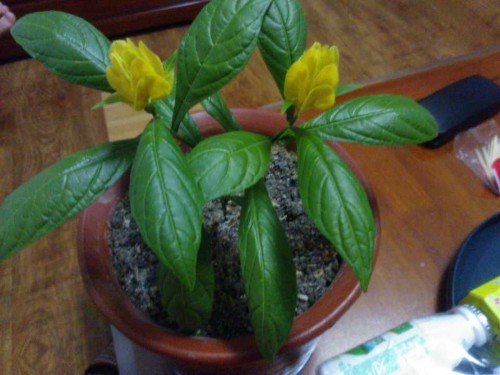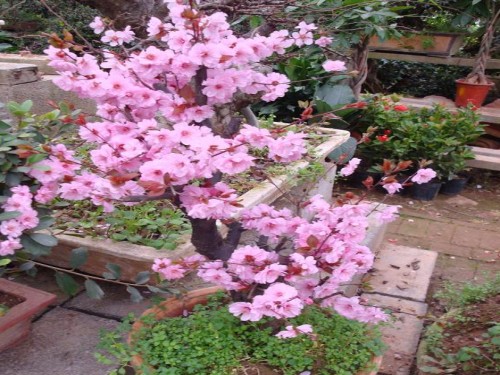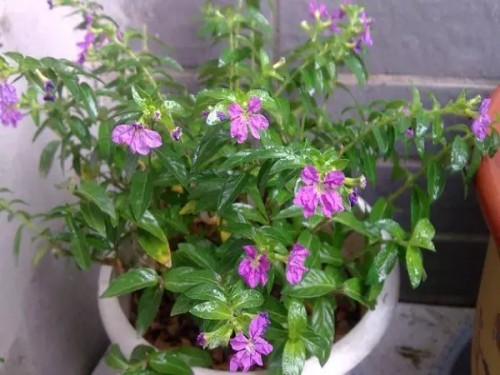Culture method of potted Golden Bract Flower
Golden bract flower, also known as yellow shrimp flower, coral bed, gold and silver, golden shrimp flower, golden pagoda. Evergreen subshrubs of the family Acanthaceae, blooming in spring and autumn with strange flower patterns. Golden bract flower 30-50 cm high, stem node dilated, leaves opposite, long oval, with obvious veins, named because of the yellow spike on the top of the stem, layered bracts, and protruding white florets, shaped like shrimp.
In fact, the golden petals are only protective bracts, while the white second lip lobes growing on the bracts are the real petals. Because of its long flowering period, high ornamental value, tidy clumps of golden bracts, bright yellow flowers and long flowering period. Suitable for meeting hall, hall, living room and balcony decoration. In an environment of more than 15 ℃, whenever a new shoot appears, there will be a new inflorescence at the top, which can be viewed all the year round.

Golden bracts have neat clusters of plants, bright yellow flowers and a long flowering period. Suitable for meeting hall, hall, living room and balcony decoration. The south is used to decorate flower beds and can also be used as flower borders. Warm land can be planted in the garden, while the north is used as greenhouse potted flowers, which is an excellent variety of potted flowers. The following is to introduce the breeding methods of Golden Bract Flower.
[soil]
It can be mixed with 5 parts of rotten leaf soil, 3 parts of garden soil, 1 part of river sand and 1 part of mature organic fertilizer. The soil is loosened every half month in the growing season, and the basin must be turned and changed before leaving the house every spring. The basin soil is required to be loose, breathable, fertile and rich in humus, which is often mixed with peat soil, rotten leaf soil or peat soil plus perlite or vermiculite of 1 peat 2 and river sand of 1 peat 3, and mixed with a small amount of mature cow dung as base fertilizer.
[light]
Full light can be received in spring and autumn, 30% to 40% should be shaded in the middle of summer, or about half a day's light should be maintained in the morning and evening, but it is best to leave it in front of a warm and sunny southward window in winter. During the growth period, sufficient light should be given except for a little shade in the middle of summer, which can not only make the plant grow stronger, but also reduce diseases. Although this flower can grow well in semi-shaded environment, if it is too shaded, it will grow too much, and it will blossom later and less. In addition, Jinbao prefers the sun, cultivated in the north, and should be maintained outdoors in spring and autumn, generally without shading, but appropriate shading is needed around noon in summer. If exposed to the hot sun, it is easy to lead to leaf withering, leaf edge scorching. Put in the greenhouse where there is enough light in winter, the leaves are bright green and full of luster, the plant type is compact, the inflorescence is large, and the color is bright.
[temperature]
The optimum temperature for the growth of Golden Bract is about 15 ℃-25 ℃, and it is disadvantageous to its growth when it is more than 30 ℃ or less than 10 ℃. In summer, when the temperature reaches more than 30 ℃, it is necessary to create a relatively cool environment by setting up a shed to shade and spray water. During the overwintering period, it requires that the indoor should not be less than 10 ℃, otherwise it is very easy to cause all the leaves of the plant to be lighted, and if it is less than 4 ℃ to 5 ℃, it will freeze to death. For plants placed indoors in winter, it is best to heat them with an electric heater.
Low temperature can easily cause leaf shedding, root rot will be caused for a long time, and in severe cases, the plant will wither and die. Therefore, in order to keep it blooming in winter, the northern family should keep it in the greenhouse, keep the room temperature above 18 ℃ during the day and more than 10 ℃ at night, and give it proper fertilizer and water at the same time.
In winter, you should move into the sunny place indoors, slightly control the watering, and the temperature should not be lower than 10 ℃, otherwise the leaves will yellowed and fall off due to low temperature, and the root system will rot for a long time, and even die in serious cases. In winter, if the day is not less than 25 ℃ and the evening is about 15 ℃, the plant can blossom and can be watered and fertilized normally.
[watering]
The growing season should not only keep the basin soil moist, but also require higher relative air humidity, but there can be no stagnant water in the basin soil. Attention should always be paid to improving the air humidity around flowerpots in summer and dry seasons. The growing season should not only keep the basin soil moist, but also require higher relative air humidity, but there can be no stagnant water in the basin soil.
It is watered once a day in spring and autumn. It should be watered 2-3 times a day in summer, once before 10:00 in the morning and once after 3pm, and appropriately increase the times of foliar spraying. Keep the basin soil slightly moist in winter. It is necessary to prevent stagnant water from rotting roots in the rainy season.
[fertilization]
In the growing season, mature organic fertilizer or urea + potassium dihydrogen phosphate is sprayed with water every 15-20 days. Keep in mind that nitrogen fertilizer should not be too much, otherwise it is easy to cause slender stems and reduce the number of flowers. 0.2% potassium dihydrogen phosphate solution should be sprayed on the leaves during the budding period, which is beneficial to the colorful flowers. Phosphorus and potassium fertilizers should be applied twice during flowering to meet the nutritional needs of pregnant buds. When the ambient temperature is higher than 35 ℃ or lower than 15 ℃, fertilization should be stopped. If the fertilizer is insufficient in the maintenance process, the plant growth will slow down, the leaf color will be dim, and the inflorescence will be small and small. In addition, the irregular addition of 0.1% ferrous sulfate powder can ensure that the leaves are green and glossy, but also prevent the yellowing phenomenon of the leaves.
[pruning]
Seedlings that have just survived by cutting should be heart-picked, once when the seedling height is about 6 cm, and again when the branch grows to about 4 cm, in order to promote branching, buds and flowers can be conceived and blossomed on the new branch after one month. A pruning should be carried out in combination with turning the basin every spring, which should generally cut off about 1 / 2 of the plant height. This can not only control the height and promote the branching, but also avoid the collapse of the lower leaves and affect the ornamental.
Time: 2019-06-01 Click:
- Prev

Maintenance and management methods of Prunus mume
The elm leaf plum gets its name because its leaves look like elm leaves. The leaves of the elm leaf plum are like elm trees and its flowers are like plum blossoms, so it is named after the elm leaf plum. With dense branches and leaves and colorful flowers, Prunus mandshurica is an important green flowering shrub species in gardens, streets, roadsides and other important trees in northern China. Want the elm leaf plum to blossom and flourish in early spring
- Next

The cultivation method of purple calyx flower
Purple calyx distance flower is also called purple sky star, for celandine calyx distance flower genus, erect small shrub. Purple calyx distance flower because of luxuriant foliage, dark green leaves, evergreen, and has luster, beautiful flowers and annual flowering, easy to form, resistant to pruning, has a strong greening function and ornamental value
Related
- Fuxing push coffee new agricultural production and marketing class: lack of small-scale processing plants
- Jujube rice field leisure farm deep ploughing Yilan for five years to create a space for organic food and play
- Nongyu Farm-A trial of organic papaya for brave women with advanced technology
- Four points for attention in the prevention and control of diseases and insect pests of edible fungi
- How to add nutrient solution to Edible Fungi
- Is there any good way to control edible fungus mites?
- Open Inoculation Technology of Edible Fungi
- Is there any clever way to use fertilizer for edible fungus in winter?
- What agents are used to kill the pathogens of edible fungi in the mushroom shed?
- Rapid drying of Edible Fungi

